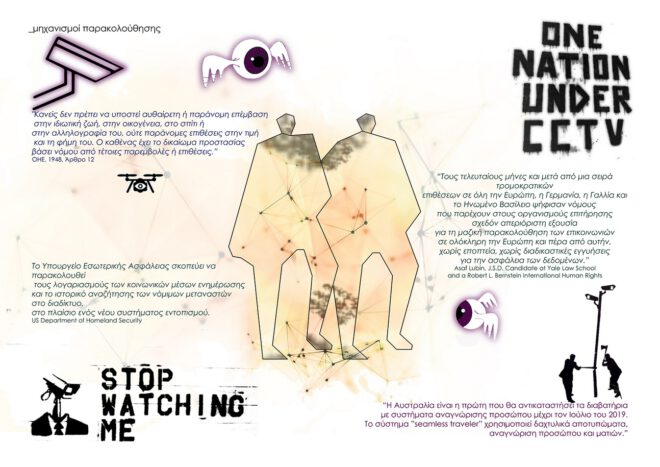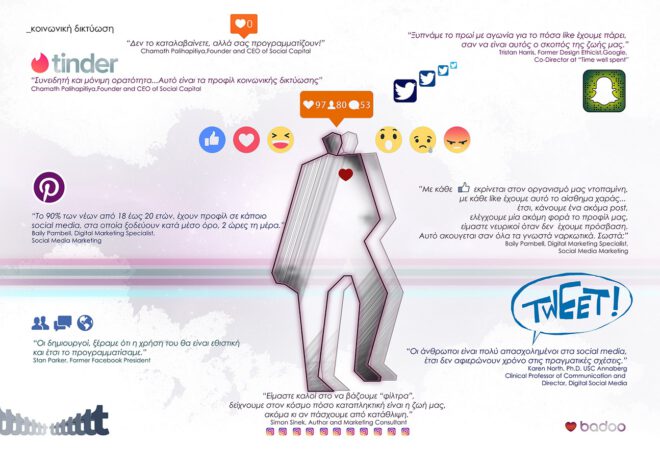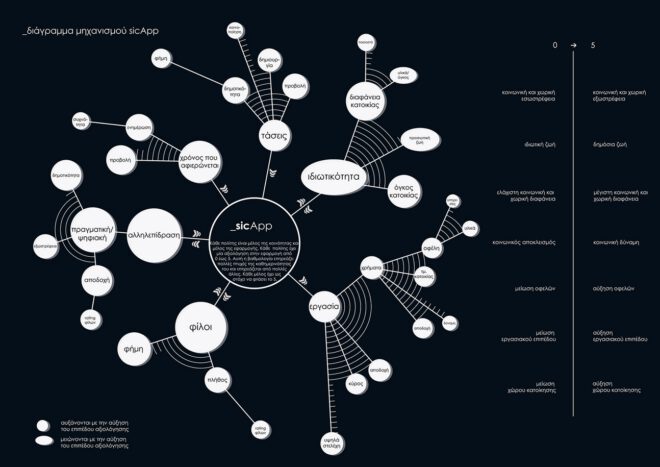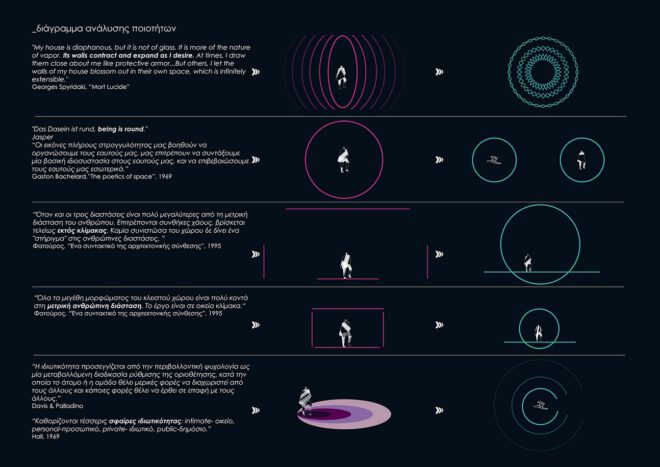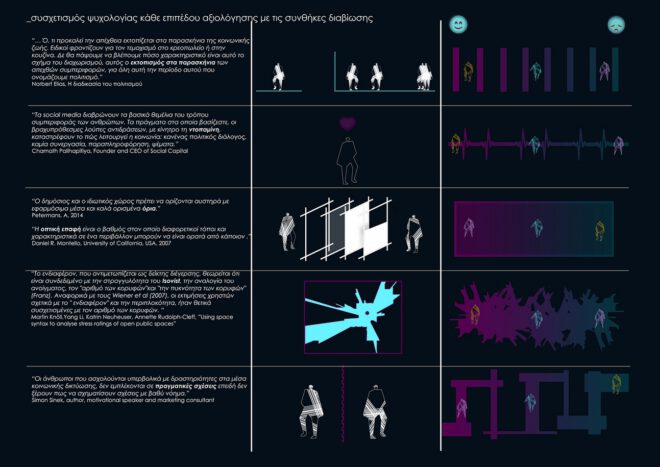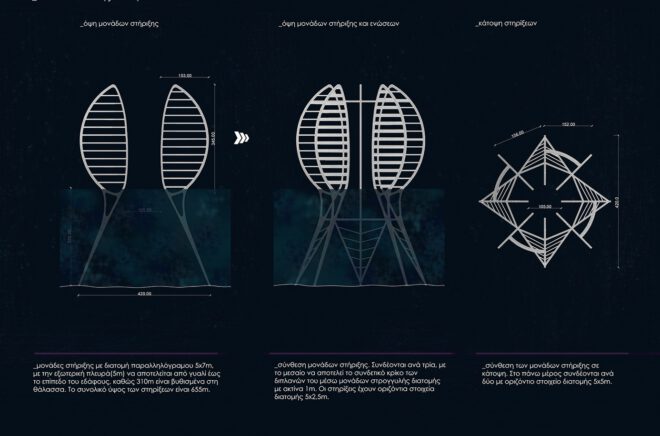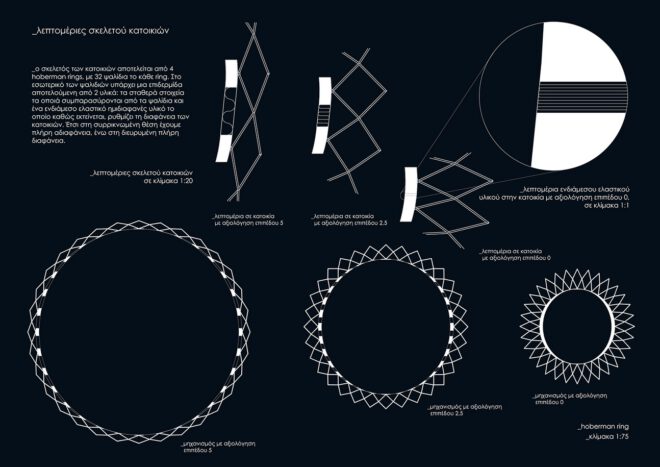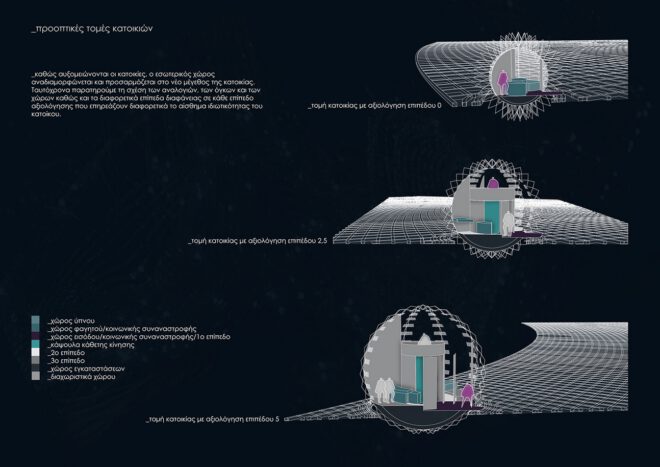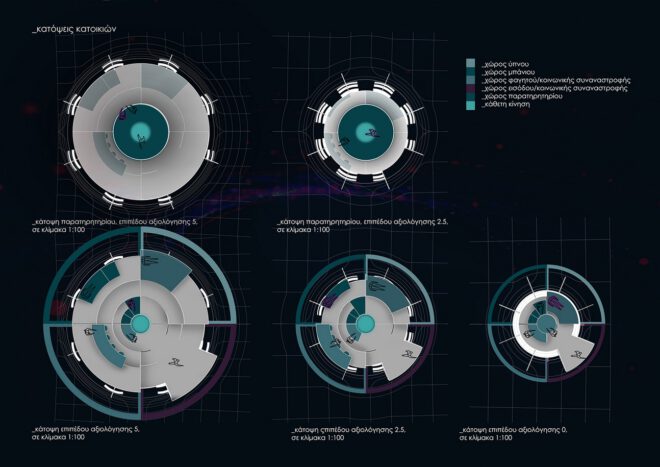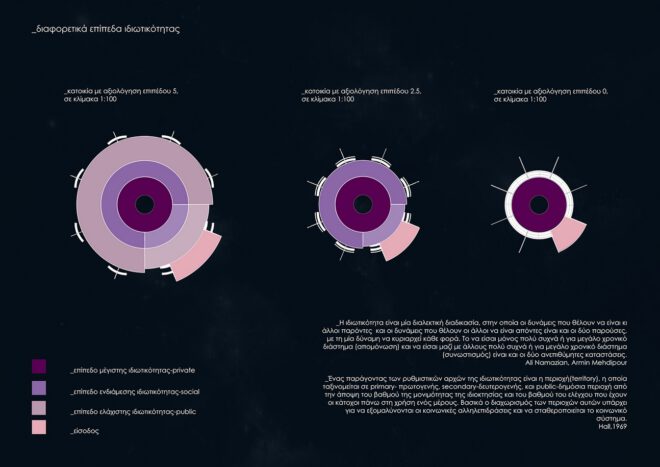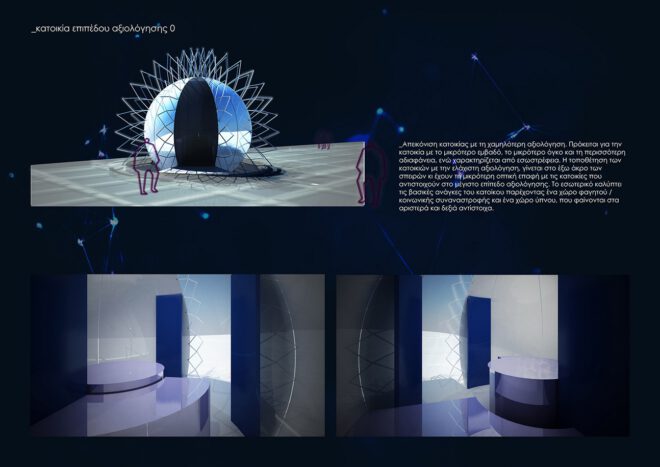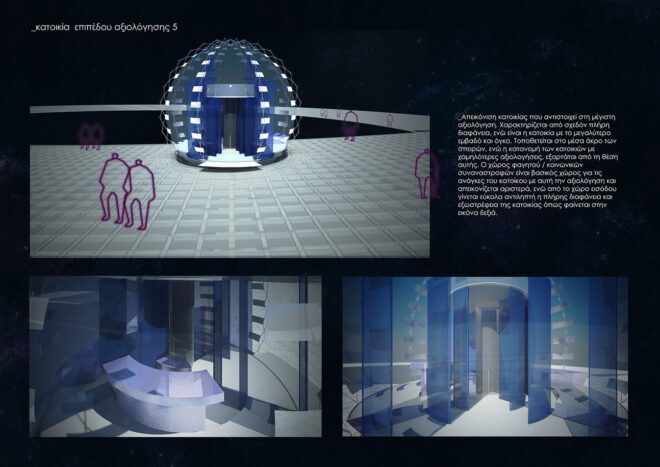H ερευνητική εργασία της Μαρίας Καλαϊτζάκη και της Θεοδώρας Σερδάρη, με τίτλο “ Socially Inteconnected Community -SIC”, αναλύει έναν μελλοντικό κόσμο όπου οι άνθρωποι διαιρούνται σε αυτόνομες κοινότητες και μέσω των κοινωνικών μέσων δικτύωσης προβάλουν την προσωπική τους ζωή.
Η εργασία παρουσιάστηκε τον Μάρτιο του 2018 στην Αρχιτεκτονική Σχολή του Πανεπιστημίου Πατρών με επιβλέπουσα καθηγήτρια την Αικατερίνη Λιάπη.
-κείμενο από τους δημιουργούς
Οι προτεραιότητες των ανθρώπων έχουν αλλάξει. Μία κοινωνική πλατφόρμα που προβάλει την προσωπική τους ζωή είναι αυτό που κυριαρχεί στις ζωές τους παραδίνεται στην τυχαιότητα του βλέμματος, στο φευγαλέο και το ευρηματικό, στα ταξίδια του νου και τα ερωτήματα που γεννά η περιπλάνηση στην πόλη.
Η πλατφόρμα θέτει τους κανόνες και η κοινωνία έχει υποχρέωση να υπακούει σε αυτούς. Έτσι, δημιουργείται μία νέα δομή κοινωνίας με συγκεκριμένες κοινωνικές κάστες. Η ζωή έχει γίνει μία συνεχής προσπάθεια για την επίτευξη του μεγαλύτερου επιπέδου αξιολόγησης και όσων αυτό προσφέρει. Η επίτευξη αυτού είναι ο στόχος όλων, οπότε ακολουθούν τον τρόπο ζωής που επιβάλλουν οι τάσεις.
Υπόθεση:
α. Η περιβαλλοντική καταστροφή έχει φτάσει σε ένα μη αναστρέψιμο σημείο. Η γη έχει γίνει ένα αφιλόξενο μέρος και η μοναδική επιλογή είναι η κατοίκηση σε περίκλειστες κοινότητες με ελεγχόμενες συνθήκες οι οποίες θα επιτρέπουν τη συνέχιση της ανθρώπινης ζωής.
β. Η μελλοντική κοινότητα θα είναι αυτόνομη. Θα μπορούν να παράγουν όλα τα απαραίτητα και να εξυπηρετούν κάθε ανάγκη τους.
γ. Η κοινωνία λειτουργεί με βάση τους κανόνες που προκύπτουν από μία πλατφόρμα κοινωνικής δικτύωσης, στην οποία κάθε κάτοικος έχει προφίλ και με βάση τη δραστηριότητα του σε αυτό, βαθμολογείται από τους υπόλοιπους κατοίκους.
δ. Οι κάτοικοι δεν αναπτύσσουν πραγματικές διαπροσωπικές σχέσεις, κι έτσι το πρότυπο της οικογένειας εξαφανίζεται. Οι κάτοικοι έχουν ως κύριο στόχο της κοινωνική ανάδειξη.
Οι κανόνες εκτός από τη διαμόρφωση της κοινωνικής συμπεριφοράς των κατοίκων, διαμορφώνουν και τη βάση της σύνθεσης του χώρου τους. Όσο ο βαθμός αξιολόγησης του κάθε κάτοικου αυξάνεται, τόσο μειώνεται η ιδιωτικότητα του. Η μεγαλύτερη αξιολόγηση έχει ως αποτέλεσμα ένα είδος δημόσιας ζωής, που περιλαμβάνει τη μεγαλύτερη κοινωνική και χωρική διαφάνεια και δημοτικότητα. Από την άλλη, η χαμηλότερη αξιολόγηση, έχει ως αποτέλεσμα την κοινωνική και χωρική εσωστρέφεια του κατοίκου, τον κοινωνικό αποκλεισμό και τη μείωση των παροχών. Ο τρόπος ζωής είναι αυτό που ελέγχει την κατοικία, τα όρια της, το φωτισμό της και τη διαφάνεια της. Ένα βασικό στοιχείο του σχεδιασμού της κατοικίας είναι το διαφορετικά επίπεδα ιδιωτικότητας βασισμένα στη θεωρία του Hall, τα οποία αντιστοιχίζονται σε κάθε επίπεδο αξιολόγησης. Υπάρχει (ή όχι) απόλυτος διαχωρισμός του ιδιωτικού χώρου και του δημόσιου, τα όρια εκφράζονται διαφορετικά σε κάθε κατοικία. Όσο αυξάνεται το μέγεθος της κατοικίας η ιδιωτικότητα ελαχιστοποιείται, αλλά η απομόνωση αυξάνεται όσο το μέγεθος της κατοικίας μειώνεται.
Οι κατοικίες αποτελούνται από κινηματικές κατασκευές που αυξομειώνουν το μέγεθος τους, ενώ το εσωτερικό τους προσαρμόζεται σε αυτό, ανάλογα με το επίπεδο αξιολόγησης του ιδιοκτήτη. Η δυνατότητα να αυξομειώνεται οφείλεται στη δομή της Hoberman Sphere, υπερβαίνοντας τη γεωμετρίας της. Ο κάτοικος καθορίζει το χώρο και ο χώρος καθορίζει τον κάτοικο. Αυτή η κίνηση είναι εφικτή, αφού κάθε κατοικία τοποθετείται πάνω σε ένα ελαστικό κάναβο, τα κελιά του οποίου προσαρμόζονται σε κάθε αλλαγή. Οι κάτοικοι είναι σε συνεχής και μόνιμη έκθεση, ο βαθμός της οποίας εξαρτάται από το επίπεδο αξιολόγησης του κάθε κατοίκου. Τα χαμηλότερα επίπεδα το βιώνουν σε μικρότερο βαθμό, όμως όσο το επίπεδο αξιολόγησης αυξάνεται ,το αίσθημα του Panopticon αυξάνεται εξίσου.
Στοιχεία έργου
Τίτλος εργασίας : Socially Interconnected Community – SIC
Τύπος: Ερευνητική εργασία
Ημερομηνία: Μάρτιος 2018
Σχολή: Τμήμα Αρχιτεκτόνων Μηχανικών, Πανεπιστήμιο Πατρών
Φοιτήτριες: Καλαϊτζάκη Μαρία, Σερδάρη Θεοδώρα
Επιβλέπουσα καθηγήτρια: Αικατερίνη Λιάπη
The decline of privacy, due to either the communication of the individual’s personal data to social media, or their recording by various mechanisms (state or private -controlled) is today’s reality. Thus, the question is the evolution of this phenomenon, which led to the creation of an architectural inquiry: how to visualize a space designed to translate social conditions into spatial parameters. An autonomous future community is created, that operates based on the rules which arise from the operative logic of social media.
Hypothesis:
a. The environmental disaster has reached an irreversible point. The land has now become an inhospitable place and the only solution is the creation of controlled living conditions in enclosed communities that will allow the continuation of the human species and its safeguarding from extinction.
b. The future society should be autonomous. The isolated communities should be able to produce what they need and serve every need.
c. The structure of the society operates on the basis of a social media application where each resident has an account and according to the activity on his profile he/she has a rating level.
d. Inhabitants will not develop relationships, as the family structure became abselite. People’s main goal is to rise in social ladder.
In the future, the world is divided to autonomous communities, that operate based on the rules which arise from the operative logic of social media. People’s priorities have changed. A platform that projects personal life is what dominates their life. The platform sets rules that the community is obliged to obey. Thus, a new social structure is formed, based on specific social castes. Life has become a continuous try to achieve the highest level of rating and earn all that elevation has to offer. The achievement of the highest score is the target of all inhabitants, so they follow the lifestyle imposed by the trends.
These rules, besides shaping the social behaviour of the inhabitants, also form the basis for the composition of space. The society is built in such way, that the target of every inhabitant is to increase social popularity, a goal that is attainable through following the overall tendencies and regulations.
As the rating level increases, the privacy of the individual minimizes. Thus, the highest rating level has as a consequence the ”public life”, that includes the highest social and spatial transparency and popularity. On the other hand, the lowest rating level, has as a consequence the social and spatial introspection of the resident, social exclusion and the reduction of benefits. Lifestyle is what controls the home, its limits, its lighting, and transparency. A key element in housing development is the different levels of privacy, based on Hall’s theory, that correspond to each level of social rating. There is (or not) a clear distinction between private and public space, borders and limits are expressed in different ways for each residence. While the size of the residence increases, the resident’s isolation diminishes, but their isolation increases as the residence size is reduced.
Residences consist of kinetic structures that change their size and adapt their interior space according to the rating the owner has achieved in the platform. Each house transformation is based on the structure of Hoberman Sphere, exceeding its geometry according to the rating fluctuations of its occupant. The inhabitant defines the space, the space defines the inhabitant. This movement is enabled by a grid that the house is placed on, its cells adjust to every size of the residence. The inhabitants of this community are in permanent and continuous exposure, the degree of which depends on the rating level of each resident, the lower rating levels experience this to a lesser degree, and the feeling of Panopticon becomes more intense as the rating level increases.
Through the theoretical references which were investigated, it is assumed that the inhabitants with the lowest rating levels, who are at least affected by the Panopticon conditions created in the community, should seek to remain at low levels. This, however, is not happening because low rating levels experience social exclusion, as society has been structured based on social media rules. This situation verifies the theory of “Spiral of Silence”, which in essence expresses the individual’s fear of social exclusion that leads him to adopt the behaviour of the majority.
Facts & Credits
Project Name: Socially Interconnected Community – SIC
Typology: Diploma Thesis
Project Date: March 2018
School: Department of Architecture, University of Patras
Students: Kalaitzaki Maria, Serdari Theodora
Supervisor professor: Aikaterini Liapi
READ ALSO: Blueprints of nature | Όταν η αρχιτεκτονική εμπνέεται από τη φύση
